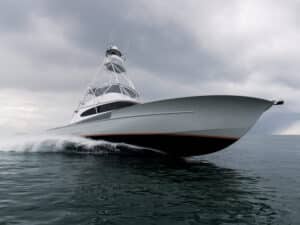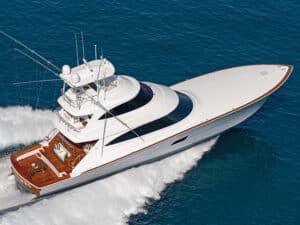First-edition rare books, original art by a master, hand-carved sculpture, fine rugs, tapestries, one-of-a-kind furniture and architectural design all have one thing in common: The creator always has one piece of work that represents the pinnacle of his or her creative ability.
John Whiticar has built many beautiful boats in his lifetime, and God willing will build many more. However, his 56 (currently named Picasso) probably stands as his singular masterpiece. It’s certainly the most extravagantly detailed boat Whiticar has ever built. As one who gets aboard virtually every model of boat built in America today, I can assure you that few sport-fishing boats out there compare with the Picasso in terms of sheer beauty.
Performance
At test time, the Whiticar 56 was using only 93 percent of the Detroit 12V-183s’ available horsepower. Playing with the props should improve top end, though midrange response is so good that I’d really hesitate to change a thing. It took a mere 13 seconds to plane, which is remarkably quick, compared with many 56-footers.
Very quiet at trolling speed, the 56 remains that way even at 2,450 rpm, where it hit its top speed of 35 knots. Whiticar has hit just the right balance in the running gear. At 25 knots, the 56 carves a 180-degree turn in about three boat lengths, and incremental course changes are instantaneous. Another clue to how efficient this hull is can be found by chopping the throttles from full speed. The 56 glides for an inordinately long distance, and the wake never rises up the transom, either. Oh, and try this with your boat: The Whiticar 56 readily got up on plane and ran 19.5 knots with only one engine!
I experienced a considerable range of motion with trim tabs; the bow lifts nicely for down-sea running but drops to an almost flat running angle for head seas.
Fishability
With the electronic controls and trolling valves, the 56 can troll at 1 knot for perfect live-baiting – and does it very quietly. You get a perfect view of the cockpit from the helm, though only about the forwardmost third of the bow can be seen from the wheel.
Other boats may back down faster than this 56’s 5 knots, but most of the time an angler can’t reel fast enough to keep up with a higher speed than that anyway. It spins nicely with the wheel centered, but turn the wheel and the pivot time drops by half. Not being a speed demon, the Whiticar 56 enjoys a very reasonable length-to-beam ratio, affording it a wonderful stability in a beam sea.
From a captain’s point of view, Whiticar did a brilliant job designing and executing the overhead teaser reel compartment. The hatch’s forward edge lifts up, and the hatch slides forward internally. Slide it aft, and it just drops into place. You’ll never smack your head on the teaser reels on this boat, nor will you have the hatch drop and hit you in the noggin.
Construction
For those who haven’t looked to catch the price of this boat yet, it’s $3.8 million. Whiticar explained one of the reasons for the higher cost: “We strictly use mahogany strip planking in our cold-molded hulls rather than the standard marine plywood most builders use. It keeps [water] migration problems to a minimum, especially around thru-hulls, and it also eliminates the delamination concerns that can occur with some plywoods over time. It doesn’t transfer vibration as readily and absorbs the epoxy better. Overall, I think it provides better longevity.” The price includes almost a million dollars of extra paneling, fixtures, joiner work and the like – but more on that later.
The 56 got three layers of stripping on the bottom and two in the topside, all bonded together with expensive epoxy resins. Fairing blocks mount on the leading edge of all water intakes.
Flybridge
Flybridge ladders are simply a necessary evil. It’s tough to make one that is easy to both climb and descend. The 56 ladder does a better than average job, starting out vertical and then slanting forward to almost stairway angle, making it super easy to climb.
You’ll find storage under all settees, coaming and the console. Though there’s enough room to pass behind the helm seat on the way to the companion seat, they are set so close together it’s a squeeze to get between them into the seat.
Thankfully, the magnetic compass sits right in front of the helmsman so it can be easily read. The hardtop above the helm sports four flush-mounted speakers for stereo, SSB and VHF.
The wraparound instrument panel works extremely well, with every button within easy reach of the helmsman. Whiticar adds seals and drainage channels to each cover. What I like most about the wraparound instrument area is it provides enough room to eliminate the need for an overhead instrument box, making for a much cleaner, more open feeling.
Interior
Step into the salon, and you immediately see where most of the extra cost came from. The all-teak interior includes hand-carved scallop-shell handles on every cabinet and drawer, teak beveled panels and hideaway compartments throughout the companionway, a hidden foldout table between custom swivel armchairs to starboard and a custom-built salon table that raises and lowers at the touch of a remote-control device. (It also has leaf inserts for more dining space and a lockout switch so you can’t put the table down on people’s legs with the leaves inserted.) Tallying the extra joiner work, I figure that the Whiticar 56’s custom interior required about 50 times more work than if it just had wall coverings or plain veneer panels.
It took three years and an extra million dollars, but every bit of veneer aboard is book matched. Every bit of teak aboard Picasso – the toenail, caprail, cockpit cabinetry, and transom (except the deck) – came from a single log and matches perfectly.
This 56 provides a remarkable amount of storage everywhere – almost all of it hidden away for a super clean atmosphere. Adding to the clean look are half-height reefers and freezers under galley counters (though not the drawer type), and Corian counters with elegant brass fixtures and fittings.
Lots of hidden features require ways to expose them. Everywhere you go aboard the Whiticar 56, you find remote controls and electronically actuated parts. Normally I wouldn’t mention the entertainment system as it is strictly an owner-chosen feature. However, Picasso boasts an awesome flat-panel TV and home theater system in the salon. I mention it because Whiticar fabricated the most beautiful handmade teak grates in the salon pillars and bulkheads to hide the high-end speakers.
A commercial Clear-Cube icemaker always has 50 pounds of ice cubes ready, and wine and dish storage hide in slide-out compartments.
Belowdecks, the master head is so elegant it makes the guest head look like the poor country cousin. I particularly love the molded wood sink.
Cockpit
John Whiticar’s boats don’t just look good, they fish well, too. Behind the portside ladder sits a large stainless-steel freezer enclosed in a beautiful teak cabinet for bait and food on longer trips. The owner who initially commissioned this boat opted for a single large fish box in the transom with an Eskimo Icemaker that pumps 600 pounds of chipped ice into the box daily. You’ll never run short.
As elsewhere aboard, Whiticar lets little dead space go to waste: There’s an insulated drink box inside the salon steps, and gunwale cabinets hold mops, gaffs, hoses, etc. The caprail rises to mid-thigh and allows plenty of toe space under the rail to keep your center of gravity inboard when reviving a fish.
Many little touches make a big difference. For example, most cockpit hatches that have positive dogs scratch the teak if set down on the deck. The Whiticar has four “feet” covered in rubber crutch tips so that when you lift the hatch and set it on deck, you do so with impunity.
Some of today’s professional crews might feel intimidated stepping aboard Picasso. After one look at the magnificent varnish work, they suck their teeth at what they consider a headache. Whiticar does a fabulous job building up the varnish on the surfaces of the 56. The cockpit can easily be cared for in much the same way as fiberglass. Wash and gentle chamois keep it fine for long periods between touch-ups. The interior varnish just needs an occasional wipe with a soft cloth. You needn’t be frightened by the thought of maintenance.
Engine Room
A centerline engine hatch opens to reveal Flo-Scan and tank gauges, switches for pumps and lights right at hand. You needn’t climb into the compartment to read their status or use the switches.
I would have preferred the Westerbeke generator to be located aft, away from the master stateroom instead of on the forward bulkhead. And though the battery switches sit outboard of the engines, I found it relatively easy to crawl outboard to reach them. The engine compartment stands as a model of clean engineering. You don’t see any wires or piping anywhere.
A Turkish rug weaver once told me that he always put mistakes into his rugs because only God is perfect. John Whiticar obviously subscribes to this philosophy, too. His 56-foot Picasso may not be the fastest sport-fisherman on the water, but with a few minor exceptions, it comes as close to perfection as you’re likely to find in today’s custom boat market.







